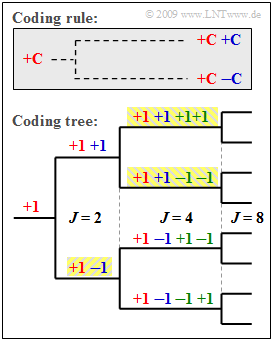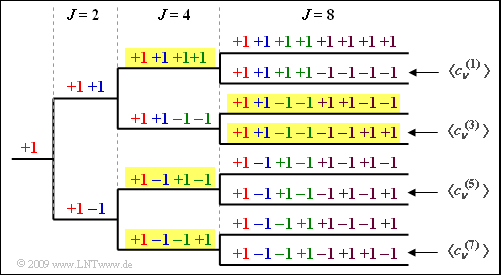The spreading codes for UMTS should
- all be orthogonal to each other to avoid mutual interference between subscribers,
- be as flexible as possible in order to realize different spreading factors $J$ .
An example of this are the so-called Orthogonal Variable Spreading Factor (OVSF) codes, which provide spreading codes of lengths from $J = 4$ to $J = 512$ . These can be created using a code tree, as shown in the diagram. Thereby, at each branch from one code $\mathcal{C}$ two new codes are created.
- $(+\mathcal{C} \ +\hspace{-0.05cm}\mathcal{C})$,
- $(+\mathcal{C}\ -\hspace{-0.05cm}\mathcal{C})$.
The diagram illustrates the principle given here by the example $J = 4$.
If we number the spreading sequences from $0$ to $J -1$ we get here the spreading sequences
- $$ \langle c_\nu^{(0)}\rangle \ = \ {+\hspace{-0.05cm}1}\hspace{0.15cm} {+\hspace{-0.05cm}1} \hspace{0.15cm} {+\hspace{-0.05cm}1}\hspace{0.15cm} {+\hspace{-0.05cm}1} \hspace{0.05cm},\hspace{0.3cm} \langle c_\nu^{(1)}\rangle = {+\hspace{-0.05cm}1}\hspace{0.15cm} {+\hspace{-0.05cm}1} \hspace{0.15cm} {-\hspace{-0.05cm}1}\hspace{0.15cm} {-\hspace{-0.05cm}1} \hspace{0.05cm},$$
- $$\langle c_\nu^{(2)}\rangle \ = \ {+\hspace{-0.05cm}1}\hspace{0.15cm} {-\hspace{-0.05cm}1} \hspace{0.15cm} {+\hspace{-0.05cm}1}\hspace{0.15cm} {-\hspace{-0.05cm}1} \hspace{0.05cm},\hspace{0.3cm} \langle c_\nu^{(3)}\rangle = {+\hspace{-0.05cm}1}\hspace{0.15cm} {-\hspace{-0.05cm}1} \hspace{0.15cm} {-\hspace{-0.05cm}1}\hspace{0.15cm} {+\hspace{-0.05cm}1} \hspace{0.05cm}.$$
According to this nomenclature, for the spreading factor $J = 8$ there are the spreading sequences $\langle c_{\nu}^{(0)} \rangle, \ \text{...} \ ,\langle c_{\nu}^{(7)} \rangle$.
Note that no predecessor and successor of a code may be used by other participants.
- So, in the example, four spreading codes with spreading factor $J = 4$ could be used, or.
- the three codes highlighted in yellow - once with $J = 2$ and twice with $J = 4$.
Hints:
- This exercise belongs to the chapter "Telecommunications Aspects of UMTS".
- Reference is made in particular to the page "Spreading codes and scrambling with UMTS".
Questions
Solution
(1) The graph shows the OVSF tree structure for $J = 8$ user.
- From this it can be seen that proposed solutions 1, 3, and 4 are true, but not the second one.
(2) If each user is assigned a spreading code with $J = 8$ then $\underline{K_{\rm max} = 8}$ subscribers can be served.
(3) If three subscribers are served with $J = 4$ only two subscribers can be served by a spreading sequence with $J = 8$ (see exemplary yellow background in above diagram) ⇒ $\underline{K = 5}$.
(4) We denote by.
- $K_{4} = 2$ the number of spreading sequences with $J = 4$,
- $K_{8} = 1$ the number of spreading sequences with $J = 8$,
- $K_{16} = 2$ the number of spreading sequences with $J = 16$,
- $K_{32} = 8$ the number of spreading sequences with $J = 32$.
Then the following condition must be satisfied:
- $$ K_4 \cdot \frac{32}{4} + K_8 \cdot \frac{32}{8} +K_{16} \cdot \frac{32}{16} +K_{32} \cdot \frac{32}{32} \le 32 \hspace{0.3cm} \Rightarrow \hspace{0.3cm} K_4 \cdot8 + K_8 \cdot 4 +K_{16} \cdot2 +K_{32} \cdot1 \le 32 \hspace{0.05cm}.$$
- Because $2 \cdot 8 + 1 \cdot 4 + 2 \cdot 2 + 8 = 32$ the desired allocation is just allowed ⇒ Answer YES.
- Providing the degree of spread twice $J = 4$ blocks, for example, the top half of the tree, after providing one spread with $J = 8$, three of the eight branches remain to be occupied at the $J = 8$ level, and so on.

